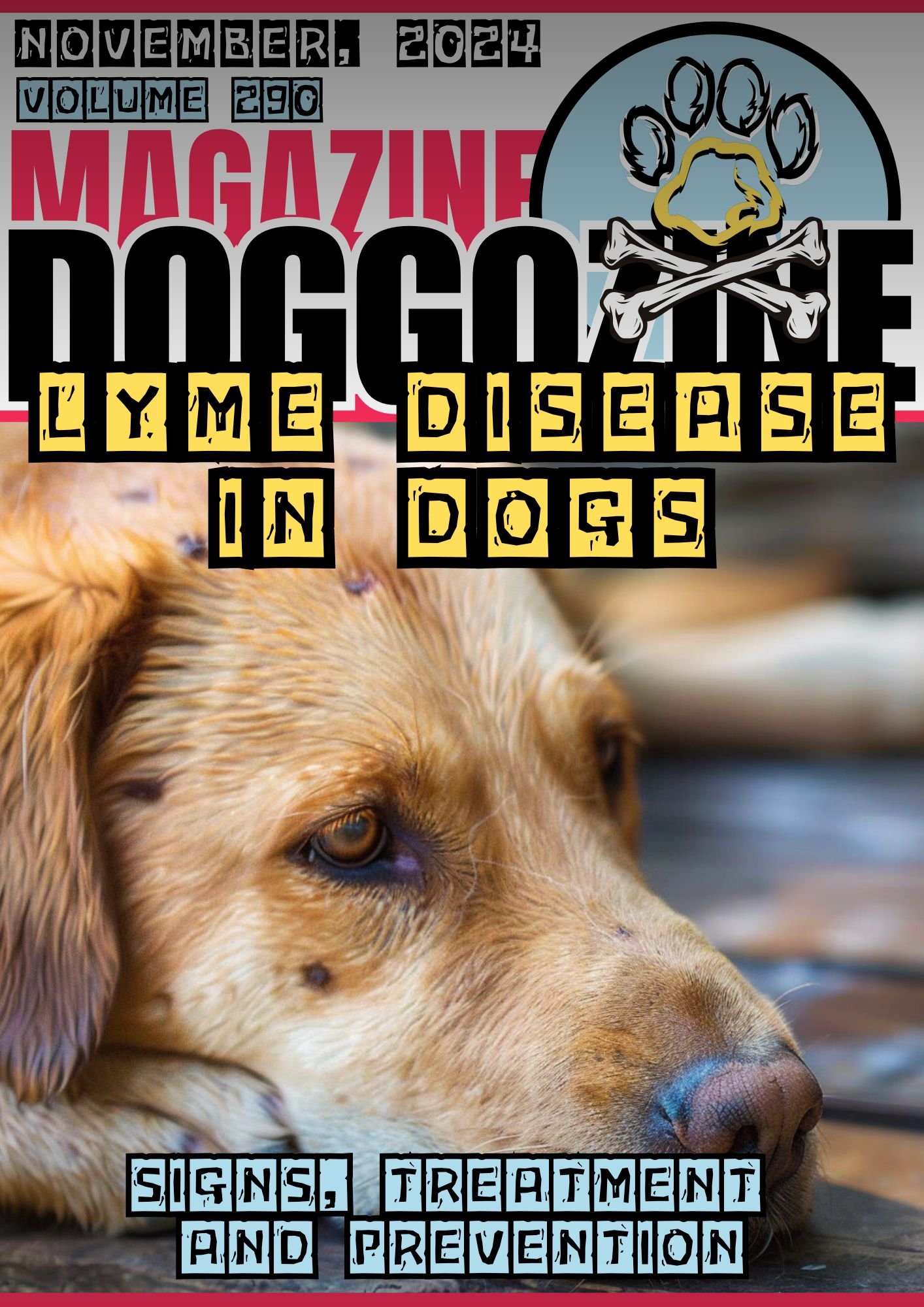Lyme disease in dogs, caused by the bacterium Borrelia burgdorferi, is a significant health concern for dogs. Transmitted through the bite of infected ticks, particularly the black-legged tick (also known as the deer tick), this disease can lead to severe health issues if not promptly diagnosed and treated.

UNDERSTANDING LYME DISEASE IN DOGS
Lyme disease is an infectious condition that affects both humans and dogs, primarily caused by the bacterium Borrelia burgdorferi. This multi-faceted disease is transmitted through the bite of infected ticks, with the Ixodes scapularis (black-legged tick) being the primary vector in the eastern and northern United States, while the I. pacificus (Western black-legged tick) is similar in the western regions.
How Lyme Disease Manifest in Dogs
In dogs, Lyme disease can manifest with a host of symptoms that may vary significantly among individual animals, making it crucial for dog owners to be vigilant. Initially, dogs infected with Lyme disease may exhibit mild fever, lethargy, and loss of appetite.
However, in more advanced cases, the condition can lead to severe joint pain and swelling, particularly affecting the dog’s knees and other large joints.
This symptomatology reflects the immune response to the bacteria, as the organism can thrive in the dog’s bloodstream and organs, causing systemic issues. It’s also worth noting that not all infected dogs will display observable symptoms, which complicates timely diagnosis and treatment.
Signs And Symptoms of Lyme Disease in Dogs
The symptoms of Lyme disease in dogs can be quite varied and may not appear until several months after a tick bite.
Here are the detailed signs to watch for:
- Fever: A persistent fever with an elevated body temperature is often one of the first signs and often one of the first indicators.
- Loss of Appetite: Dogs may show a decreased interest in food, which can lead to weight loss.
- Reduced Energy: Lethargy or a general lack of energy is common, making dogs less active than usual.
- Lameness: This can be intermittent and may shift from one leg to another. It can also recur, causing significant discomfort.
- Joint Swelling: Inflammation and swelling in the joints can cause pain and difficulty in movement.
- General Stiffness and Pain: Dogs may appear stiff or in pain, particularly after resting.
- Swollen Lymph Nodes: Enlarged lymph nodes can be a sign of infection.
- Kidney Issues: In severe cases, Lyme disease can lead to kidney failure, which can be fatal.
- Cardiac and Neurological Issues: Although less common, Lyme disease can cause serious heart and nervous system problems.
Diagnosis of Lyme Disease in Dogs
Diagnosing Lyme disease in dogs involves a combination of clinical signs, medical history, and diagnostic tests. Veterinarians look for clinical signs and may use specific tests to detect antibodies against Borrelia burgdorferi.
- Physical Examination: Veterinarians will look for clinical signs such as fever, lameness, and swollen joints.
- Blood Tests: Specific tests can detect antibodies against Borrelia burgdorferi. The most common tests include the C6 antibody test and the Quantitative C6 test.
- Urine Tests: These can help detect proteinuria, which is a sign of kidney damage associated with Lyme disease.
- PCR Tests: Polymerase chain reaction (PCR) tests can detect the DNA of Borrelia burgdorferi in the blood or tissues.

Treatment for Lyme Disease in Dogs
The primary treatment for Lyme disease in dogs is antibiotics, with doxycycline being the most commonly prescribed. The typical course lasts about four weeks, but the duration can vary depending on the severity of the infection. Pain relief medications may also be administered to help with joint discomfort.
Here are the details:
- Antibiotics: A typical course lasts about four weeks, but the duration can vary depending on the severity of the infection. Other antibiotics like amoxicillin or azithromycin may also be used.
- Pain Relief: Non-steroidal anti-inflammatory drugs (NSAIDs) may be prescribed to alleviate joint pain and inflammation.
- Supportive Care: In severe cases, supportive care such as intravenous fluids or hospitalization may be necessary to manage symptoms and prevent complications.
Prevention of Lyme Disease in Dogs
Preventing Lyme disease is crucial and involves several strategies:
- Tick Control: Use tick preventatives recommended by your veterinarian. These can include topical treatments, collars, and oral medications.
- Regular Checks: After outdoor activities, thoroughly check your dog for ticks. Prompt removal of ticks can prevent the transmission of Lyme disease, as it typically takes 24-48 hours for the bacteria to be transmitted.
- Vaccination: In areas where Lyme disease is prevalent, vaccination may be recommended as part of a comprehensive prevention plan.
🔑 Key Points: Lyme disease in dogs, caused by the bacterium Borrelia burgdorferi, is a significant health concern for dogs. The symptoms of Lyme disease in dogs can be quite varied and may not appear until several months after a tick bite. The primary treatment for Lyme disease in dogs is antibiotics, with doxycycline being the most commonly prescribed.

ADDITIONAL INSIGHTS INTO LYME DISEASE IN DOGS
Lyme disease in dogs is a serious condition that requires prompt attention. By recognizing the symptoms early and seeking veterinary care, you can help ensure your dog remains healthy and happy. Regular tick prevention and monitoring are key to protecting your furry friend from this potentially debilitating disease.
Uncommon Symptoms
While the common symptoms of Lyme disease in dogs include fever, loss of appetite, and lameness, there are some fewer common signs that can also occur:
- Behavioral Changes: Some of the dogs may exhibit changes in behavior, such as increased aggression or anxiety.
- Neurological Symptoms: In rare cases, dogs can develop neurological issues, including seizures or facial paralysis.
- Heart Problems: Lyme disease can occasionally cause myocarditis, an inflammation of the heart muscle, leading to irregular heartbeats.
Advanced Diagnostic Techniques
In addition to the standard blood tests, there are more advanced diagnostic methods being used:
- Quantitative C6 Test: This test measures the level of C6 antibodies, providing a more precise indication of infection.
- PCR Testing: Polymerase chain reaction (PCR) tests can detect the DNA of Borrelia burgdorferi in blood or tissue samples, offering a highly specific diagnosis.
Recent Advancements in Treatment
There have been some promising developments in the treatment of Lyme disease:
- Combination Therapy: For severe cases, especially those involving kidney complications, a combination of antibiotics and immunosuppressive drugs may be used to manage the disease more effectively.
- New Antibiotics: Research is ongoing into new antibiotics that may be more effective or have fewer side effects than current treatments.

Innovative Prevention Strategies
Recent research has led to new strategies for preventing Lyme disease:
- Oral Tick Preventatives: A new clinical trial has shown that an oral systemic formulation of lotilaner, a drug used to kill ticks in dogs, can be highly effective. This treatment can kill ticks before they have a chance to transmit Lyme disease, providing a proactive approach to prevention.
- Vaccination Advances: Scientists are working on new vaccines that not only prevent Lyme disease but also protect against other tick-borne illnesses. These vaccines are designed to be more effective and provide longer-lasting immunity.
Environmental Management
Managing the environment where your dog lives and plays can significantly reduce the risk of tick exposure:
- Tick-Repellent Landscaping: Keeping your yard free of leaf litter, tall grasses, and brush can make it less attractive to ticks. Creating a barrier of wood chips or gravel between wooded areas and your lawn can also help keep ticks at bay.
- Natural Predators: Encouraging the presence of natural predators, such as birds and certain insects, can help control tick populations. By staying informed about the latest developments in Lyme disease prevention and treatment, you can better protect your dog from this serious illness.
🔑 Key Points: Lyme disease in dogs is a serious condition that requires prompt attention. Common symptoms of Lyme disease in dogs include fever, loss of appetite, and lameness. In addition to the standard blood tests, there are more advanced diagnostic methods, such as: Quantitative C6 Test and PCR testing.

CASE STUDIES ON LYME DISEASE IN DOGS
We will show you three different case studies that were made about the Lyme disease with three different dogs, that way you can see the different ways that this disease can affect many dogs and how to protect your dogs with recognizing early signs in order to prevent from spreading.
First Case Study: Polyarthritis in a Hunting Dog
- Background: A 4-year-old male Pointer, weighing 7 kg, presented with a 48-hour history of lethargy and unwillingness to walk. The dog had recently been taken on a hunting trip, although no tick infestation was reported.
- Clinical Signs: The dog was mildly febrile (39.9°C) and exhibited stiffness and reluctance to move. Physical examination revealed mild thrombocytopenia and minimally concentrated urine. Blood tests showed the presence of Borrelia burgdorferi antibodies.
- Diagnosis: The combination of clinical signs and positive serology for Borrelia burgdorferi raised suspicion for Lyme borreliosis-induced polyarthritis. Radiographs of the carpal and tarsal joints showed no erosive changes, and arthrocentesis was recommended but declined by the owner.
- Treatment: The dog was treated with a 4-week course of doxycycline. Rapid improvement in clinical signs was noted within a few days of starting treatment.
- Outcome: The dog fully recovered with no recurrence of symptoms over the following year.
Second Case Study: Lyme Nephritis in a Labrador Retriever
- Background: A 6-year-old female Labrador Retriever presented with a history of weight loss, vomiting, and increased thirst and urination over the past month. The dog lived in a tick-endemic area and had a history of tick exposure.
- Clinical Signs: Physical examination revealed dehydration, pale mucous membranes, and swollen lymph nodes. Blood tests indicated azotemia, proteinuria, and hypoalbuminemia. Serology was positive for Borrelia burgdorferi antibodies.
- Diagnosis: Based on the clinical signs and laboratory findings, a diagnosis of Lyme nephritis was made. This condition is a severe form of Lyme disease that affects the kidneys.
- Treatment: The dog was hospitalized and treated with intravenous fluids, antibiotics (doxycycline), and immunosuppressive drugs to manage the immune-mediated component of the disease.
- Outcome: Despite aggressive treatment, the dog’s condition deteriorated, and it developed acute kidney failure. The dog was euthanized due to poor prognosis and quality of life.
Third Case Study: Asymptomatic Lyme Disease in a Beagle
- Background: A 3-year-old male Beagle was brought in for a routine check-up. The dog had no clinical signs of illness but lived in an area known for high tick activity.
- Clinical Signs: The dog appeared healthy with no noticeable symptoms. Routine blood work was performed, including a Lyme disease screening test.
- Diagnosis: The screening test revealed a positive result for Borrelia burgdorferi antibodies, indicating exposure to the bacteria. However, the dog showed no clinical signs of Lyme disease.
- Treatment: Given the absence of symptoms, the veterinarian opted for a watchful waiting approach, with regular monitoring for any signs of illness. Tick prevention measures were emphasized to prevent future infections.
- Outcome: The dog remained asymptomatic over the next year, with no development of Lyme disease symptoms.
🔑 Key Points: These case studies highlight the variability in clinical presentations and outcomes of Lyme disease in dogs. Early detection and appropriate treatment are crucial for managing this disease effectively.

LATEST INSIGHTS INTO LYME DISEASE IN DOGS: WHAT’S NEW IN 2024?
According to recent statistics, Lyme disease has shown a rising prevalence among the dog population, with many cases reported in regions previously considered low-risk. This increase aligns with a broader trend of expanding tick populations, attributed to factors including climate change and urbanization. Given these developments, preventive measures remain paramount.
Dog owners are advised to employ tick-repellent treatments and maintain regular checks for ticks after outdoor activities, significantly reducing the risk of transmission. Early detection and intervention are key in managing this health concern, ensuring the well-being of dogs in 2024 and beyond.
Recent Advances in Treatment and Medication
Lyme disease in dogs has been a growing concern among pet owners and veterinarians alike, leading to significant advancements in treatment and management protocols. Recent years have seen the development of new medications specifically designed to combat Lyme disease effectively.
Among these, a noteworthy emergence is a novel class of antibiotics that exhibits enhanced efficacy against the Borrelia burgdorferi bacteria, the causative agent of Lyme disease. Clinical trials have demonstrated that these new antibiotics boast a higher success rate in eradicating the infection when compared to traditional treatments, primarily doxycycline.
Moreover, the integration of combination therapy has gained traction. This approach incorporates both conventional and newer medications, allowing for a synergistic effect that can yield quicker recovery times and improved overall health for affected dogs.
Latest Research about Lyme Disease Infection in Dogs
Research in 2024 has also shifted towards understanding the underlying biology of the Lyme disease infection in dogs, aiming to identify specific biomarkers that could lead to earlier diagnosis and tailored treatment plans that cater to individual dog needs. Additionally, veterinarians are increasingly exploring alternative and complementary therapies, which have garnered attention for their potential benefits.
Treatments such as herbal medicines, acupuncture, and nutritional supplementation have been employed alongside conventional care to support a dog’s immune system and overall well-being during recovery from Lyme disease. This integrative approach seeks to provide a more comprehensive treatment landscape, addressing symptoms holistically while managing the infection effectively.
As research progresses, the focus remains on finding innovative solutions, assessing existing treatments, and ensuring that the care provided for dogs affected by Lyme disease evolves. Keeping abreast of these developments is crucial for veterinarians and pet owners as they navigate the complexities of Lyme disease management.
Expert Opinions: What the Best Dog Doctors Say
As Lyme disease continues to pose a significant health risk to dogs, new insights from leading veterinarians and specialists shed light on how best to manage and prevent this ailment. Dog healthcare professionals emphasize the importance of awareness regarding the symptoms of Lyme disease.
Dr. Jane Smith, a veterinarian specializing in infectious diseases, notes that “early detection is crucial. Common signs include fever, lameness, lethargy, and swollen joints. Pet owners need to remain vigilant, especially in areas where Lyme disease is prevalent.”
When it comes to diagnostics, Dr. John Doe, orthopedics expert, advocates for the use of comprehensive testing methodologies. “We recommend utilizing both serologic tests and clinical examinations to establish a reliable diagnosis,” he advises.
This multi-modal approach ensures that Lyme disease is accurately identified, allowing for timely intervention. Such diagnostic initiatives are becoming increasingly accessible, fostering better outcomes for affected dogs.
Treatment Protocols are Evolving as New Research Emerges
Dr. Emily Jones underscores the significance of antibiotic choices. “Doxycycline remains the gold standard, but we must also consider the individual dog’s health status and potential resistances. Customizing treatment plans can lead to improved recovery rates,” she explains.
Incorporating adjunct therapies may further enhance the effectiveness of conventional treatments, according to multiple experts in the field. Finally, prevention remains a paramount focus for dog healthcare. Vaccination and tick control are essential aspects of safeguarding dogs.
Dr. Brian Lee states, “Regular vaccination combined with a diligent tick control program plays a vital role in minimizing the risk of Lyme disease in dogs.” These preventative measures are encouraged by veterinarians to ensure that dogs enjoy longer, healthier lives free from the threats of Lyme disease.
🔑 Key Points: Dog owners are advised to employ tick-repellent treatments and maintain regular checks for ticks after outdoor activities, significantly reducing the risk of transmission. Early detection and intervention are key in managing this health concern!

THE FUTURE OF DOGS WITH LYME DISEASE: A 2024 PERSPECTIVE
As we move into 2024, the landscape surrounding Lyme disease in dogs is evolving, driven by advancements in research, treatment protocols, and public awareness. The ongoing efforts to combat this tick-borne illness are yielding promising trends that could significantly improve the health outcomes for affected dogs.
Early Trials of Vaccines Aim to Enhance the Protective Immunity in Dogs
A key focus area for researchers is the development of novel vaccines. These vaccines aim to enhance the protective immunity in dogs. They are reducing their susceptibility to Lyme disease through a more robust prevention strategy. Early trials suggest that these innovations may soon offer pet owners a more effective means to protect their dogs from this pervasive disease.
Moreover, existing treatment protocols are also under scrutiny. Veterinary professionals are meticulously reviewing and updating guidelines based on the latest research findings. This includes exploring the effectiveness of new antibiotics and treatment regimens.
They could streamline recovery times and enhance the overall health of dogs diagnosed with Lyme disease. The integration of these emerging treatment methodologies is expected to improve the quality of care for pets suffering from this illness.
Fostering a Community-Centric Approach for Managing Lyme Disease in Dogs
As pet owners become more informed about Lyme disease, an increase in vigilance regarding prevention measures is anticipated. This includes regular veterinary check-ups, prompt tick removal, and the use of tick-control products.
Additionally, public awareness campaigns may play a critical role in fostering a community-centric approach to managing Lyme disease. They are always encouraging neighbors and dog owners to share best practices. The potential for changes in public policy is also noteworthy. Legislators may take action to allocate resources for Lyme disease research and increase funding for educational programs on prevention.
Engaging with local communities will foster a stronger, proactive approach, ultimately leading to a healthier dog population. By combining innovative research, effective prevention, and informed public policy, the outlook for dogs with Lyme disease is brighter than ever.









